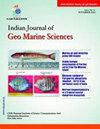Food spectrum dynamics of anadromous Hilsa, Tenualosa ilisha (Hamilton, 1822) inhabiting River Brahmaputra, India curtailing apprehension of food selectivity: An insight into its domestication
IF 0.5
4区 地球科学
Q4 Earth and Planetary Sciences
引用次数: 2
Abstract
Food and feeding habits of Tenualosa ilisha collected from two sampling locations in Brahmaputra River, Assam, India for a period of 12 months from May 2018 to April 2019 were studied. Index of preponderance revealed semi-digested animal matter (25.92 %) as the most dominant food item followed by Bacillariophyta (23.32 %). 31 genera of phytoplankton and 15 genera of zooplankton were observed in the gut of the species. Major groups of zooplankton include cladocerans, copepods, followed by rotifers, while diatoms, green algae and blue green algae were dominant phytoplankton groups. The anadromous tropical shad is planktivorous by nature and has a preference for zooplankton in smaller size groups (< 250 mm) and phytoplankton in larger size groups (> 250 mm). GaSI values (mean±SE) ranged from 1.50±0.14 to 6.93±0.89 and HSI values from 0.58±0.06 to 1.54±0.15. Index of fullness was found to range from 7.08±0.42 to 1.81±0.40. Feeding intensity, GaSI, HSI values showed seasonal variation, found to be low during October to December and high during February to June. Size group-wise analysis of feeding intensity showed high feeding intensity in lower size groups (< 250 mm) and comparatively low feeding intensity and high percentage of empty stomachs in higher size groups (> 250 mm). RLG values ranged from 1.181±0.028 to 1.450±0.052. Monthly average RLG values were found to be highest during November and in the size group of 351 – 400 mm. Changes in food composition were noticed in both months and as well as size groups.居住在印度布拉马普特拉河的无雌Hilsa, Tenualosa ilisha (Hamilton, 1822)的食物谱动力学限制了对食物选择性的理解:对其驯化的洞察
研究了2018年5月至2019年4月12个月期间在印度阿萨姆邦雅鲁藏布江两个采样点采集的ilisha Tenualosa的食物和摄食习惯。优势指数显示,半消化动物物质(25.92%)为优势食物,硅藻次之(23.32%)。在其肠道内共发现浮游植物31属,浮游动物15属。浮游动物的主要类群包括枝海动物、桡足类,其次是轮虫,硅藻、绿藻和蓝绿藻是浮游植物的优势类群。溯海热带鲥鱼是一种以浮游生物为食的鱼类,它偏爱较小的浮游动物群(小于250毫米)和较大的浮游植物群(小于250毫米)。GaSI值(平均±SE)为1.50±0.14 ~ 6.93±0.89,HSI值为0.58±0.06 ~ 1.54±0.15。丰满度指数为7.08±0.42 ~ 1.81±0.40。摄食强度、GaSI、HSI值呈季节性变化,10 ~ 12月低,2 ~ 6月高。从饲粮组角度分析,低饲粮组(< 250 mm)饲粮强度高,高饲粮组(> 250 mm)饲粮强度低,空腹率高。RLG值为1.181±0.028 ~ 1.450±0.052。月平均RLG值在11月和351 ~ 400 mm粒径组最高。食物成分的变化在两个月份以及体型组都被注意到了。
本文章由计算机程序翻译,如有差异,请以英文原文为准。
求助全文
约1分钟内获得全文
求助全文
来源期刊
CiteScore
1.50
自引率
0.00%
发文量
0
审稿时长
1.7 months
期刊介绍:
Started in 1972, this multi-disciplinary journal publishes full papers and short communications. The Indian Journal of Geo-Marine Sciences, issued monthly, is devoted to the publication of communications relating to various facets of research in (i) Marine sciences including marine engineering and marine pollution; (ii) Climate change & (iii) Geosciences i.e. geology, geography and geophysics. IJMS is a multidisciplinary journal in marine sciences and geosciences. Therefore, research and review papers and book reviews of general significance to marine sciences and geosciences which are written clearly and well organized will be given preference.

 求助内容:
求助内容: 应助结果提醒方式:
应助结果提醒方式:


